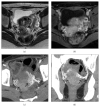Uterine Arteriovenous Fistula with Concomitant Pelvic Varicocele: Endovascular Embolization with Onyx-18®
- PMID: 29359062
- PMCID: PMC5735662
- DOI: 10.1155/2017/3548271
Uterine Arteriovenous Fistula with Concomitant Pelvic Varicocele: Endovascular Embolization with Onyx-18®
Abstract
Uterine arteriovenous fistulas are rare and acquired causes of life-threatening vaginal bleeding. They usually present with intermittent menometrorrhagia in young patients in childbearing age with history of gynecological procedures on uterus. Traditional management is hysterectomy; endovascular embolization represents nowadays an alternative strategy for patients wishing to preserve fertility. Here, the endovascular approach to a 29-year-old woman affected by severe menometrorrhagia caused by a uterine arteriovenous fistula with a concomitant pelvic varicocele is reported; a bilateral uterine arteries embolization with Onyx-18 (ev3, Irvine, CA, USA) has successfully resolved the fistula with clinical success.
Figures



Similar articles
-
Uterine arteriovenous fistula necessitating hysterectomy after two unsuccessful embolizations in an 18-year-old patient.Ann Vasc Surg. 2010 Aug;24(6):827.e9-11. doi: 10.1016/j.avsg.2010.02.041. Epub 2010 May 20. Ann Vasc Surg. 2010. PMID: 20488655
-
Transcatheter arterial embolization with ethylene vinyl alcohol copolymer (Onyx) for the treatment of hemorrhage due to uterine arteriovenous malformations.Diagn Interv Imaging. 2017 May;98(5):415-421. doi: 10.1016/j.diii.2016.09.003. Epub 2016 Oct 21. Diagn Interv Imaging. 2017. PMID: 27776896
-
Novel therapeutic strategy for uterine arteriovenous fistulas: case report.Clin Exp Obstet Gynecol. 2010;37(2):158-60. Clin Exp Obstet Gynecol. 2010. PMID: 21077514
-
Asystole During Onyx Embolization of a Pediatric Arteriovenous Malformation: A Severe Case of the Trigeminocardiac Reflex.World Neurosurg. 2017 Feb;98:884.e1-884.e5. doi: 10.1016/j.wneu.2016.07.025. Epub 2016 Jul 17. World Neurosurg. 2017. PMID: 27436213 Review.
-
Dural arteriovenous fistula in the sphenoid bone lesser wing region: Endovascular adjuvant techniques of treatment and literature review.Interv Neuroradiol. 2018 Oct;24(5):559-566. doi: 10.1177/1591019918777233. Epub 2018 May 31. Interv Neuroradiol. 2018. PMID: 29848145 Free PMC article. Review.
Cited by
-
Postpartum hemorrhage - what the interventional radiologist should know.CVIR Endovasc. 2021 Dec 13;4(1):86. doi: 10.1186/s42155-021-00277-9. CVIR Endovasc. 2021. PMID: 34902107 Free PMC article. Review.
References
-
- Barral P., Saeed-Kilani M., Tradi F., et al. Transcatheter arterial embolization with ethylene vinyl alcohol copolymer (Onyx) for the treatment of hemorrhage due to uterine arteriovenous malformations. Diagnostic and Interventional Imaging. 2017;98(5):415–421. doi: 10.1016/j.diii.2016.09.003. - DOI - PubMed
-
- Grivell R. M., Reid K. M., Mellor A. Uterine arteriovenous malformations: a review of the current literature. Obstetrical & Gynecological Survey. 2005;60(11):761–767. doi: 10.1097/01.ogx.0000183684.67656.ba. - DOI - PubMed
-
- Yokomine D., Yoshinaga M., Baba Y., et al. Successful management of uterine arteriovenous malformation by ligation of feeding artery after unsuccessful uterine artery embolization. Journal of Obstetrics and Gynaecology Research. 2009;35(1):183–188. doi: 10.1111/j.1447-0756.2008.00875.x. - DOI - PubMed
Publication types
LinkOut - more resources
Full Text Sources
Other Literature Sources

